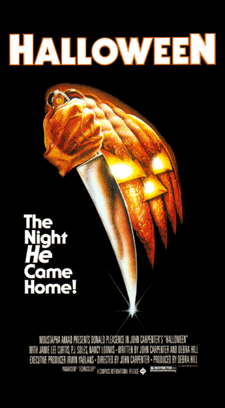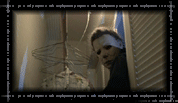


Six year old
Michael Myers murders his sister on Halloween night in 1963. He is then
taken to a mental hospital where he is studied by Doctor Loomis. Then,
in 1978, he escapes from the hospital, and on Halloween night he returns
to the town where he murdered his sister, so that he can do harm to a baby-sitter
and her friends. Halloween 1978 is the night HE came home.

"That's
when I realized that what was living behind that boys eyes was
purely and simply evil."
- Dr. Loomis |

You can thank William Shatner for Halloween. It is his face, after
all, that the infamous Michael Myers wears in the shadows of Halloween,
spray painted white and its hair frizzled up in all directions. Michael
is always in the shadows, an ever-present force with hints of supernatural
evil.
And that is where the granddaddy of horror film exceeds where all the others
fail -- in its suspense, and not in its exploitation of horror. Michael
Myers exists in the shadows as a primal fear in Halloween, preying
on innocent passersby. And although it has been falsely mistaken to be
a bloody slasher film over the years since its release, primarily thanks
to its many sequels and uncountable rip-offs, the film features virtually
no blood whatsoever. No, the film goes for real scares rather than blood
and guts. It's the Psycho of its generation, and it pays its respects
to Hitchcock in more than just the literal sense.
Its imitators and sequels all lost sight of this. Over the years, Halloween has been slowly but surely regarded with less and less respect, simply
because its imitators used its original ideas so much they turned into
clichés. By today's standards, Halloween may look tame and
quite routine, but you must understand that back in 1978 it was anything
but average and typical.
And despite the clichés, I still don't consider it average because
John Carpenter knows how to use the camera to his advantage. It's the subtle
stuff that counts -- such as the fact that we take the first person view
of Michael Myers as a child, while he murders his older sister in cold
blood. But after his parents unveil him, we never assume his perspective
ever again. Sometimes we think we are, but then we see Michael's outline
appear by the camera or far away from the camera. (Though this was ruined
when the film was chopped for TV and Michael Myers wasn't always viewable
off screen due to standard format.)
The camera also takes on the eerie presence of a third person -- when Michael
attacks Laurie in that coat closet, you're in there with her. When she
runs along the street looking for help, Carpenter uses a dolly shot and
makes the effect exist as though we are with her. As Michael drives the
stolen car through Haddonfield, we're in the back seat with him. We're
always with the characters, which is a very subtle but effective technique
that Carpenter uses, separating it from the other slasher films. It is
as though we become an unmentioned character ourselves. It almost turns
the film into a sort of adventure ride.
The film opens on Halloween night in Haddonfield, Illinois, 1963. A young
girl named Judith Myers is murdered by her 6-year-old brother, Michael.
Dr. Sam Loomis has been following Michael's case since its birth in 1963.
He worked for eight years trying to reach the boy, to connect with him.
("He hasn't spoken a word for fifteen years.") Loomis worked another seven
years trying to keep Michael locked up forever, after realizing what existed
behind the boy's cold eyes was purely and simply evil. But now, the night
of his transportation to a court hearing, Michael has escaped from confinement,
and Loomis knows where he's headed: back to Haddonfield.
Michael does come back to Haddonfield, and there he preys on innocent virginal
schoolgirl Laurie Strode, left to baby sit two children on Halloween night.
Meanwhile, Dr. Sam Loomis walks around town searching for Michael and saying
such fun, clichéd lines as, "It's your funeral!", "He came home,"
and "Evil has come to your small town, Sheriff."
One of the many keys to the film is Michael's hinted supernatural power.
Now it's common fodder to feature supernatural bad guys in horror flicks,
but back then nothing had made a villain into a supernatural mad man incarnate
before -- not even Psycho. Michael is the villain who always knows
where to hide, where the hero(ine) is hiding, how to position himself in
the shadows without being seen, and how to always be a step ahead of everyone
else. He can appear to a single person in front of a bush and then disappear
behind it, gone from sight forever. The supernatural eeriness of the character
was copied in the 1986 thriller The Hitcher, where Rutger Hauer
played a homicidal hitchhiker trying to prey on a young boy for no reason
whatsoever. Hauer was played as a supernatural character but the film failed
to make any sense of anything, wandering back and forth between a mortal
foe and an immortal one. It also hinted that there was a purpose behind
Hauer's killing spree, which was never delved into.
Halloween is smarter. Myers has not motive for killing. And instead
of constantly featuring him on screen, Michael is revealed slowly and slowly,
piece by piece. First the shoulders. Then the back of the head. Then the
face from a distance. A bit closer. But he never walks around in the daylight,
right in front of the camera, because that would completely diminish the
film's creepiness. Even when Myers is seen in the dark towards the end
of the film, and finally unmasked for a brief moment, we never really feel
that we've seen him. He is still a dark figure.
All the sequels and rip-offs burned the storyline to the ground. In retrospect, Halloween is very predictable. But it still has a distinctly subtle style of psychological
horror that all the other gratuitously violent slasher cash-ins lost. This
is the granddaddy of teen slasher movies, and always will be. And after
you get past the fact that it started an entire franchise of unwanted motion
pictures, you'll realize that there's a lot more to Halloween than
meets the eye. It's a cut above the rest, so to speak.
 | |  | | 
 | | 

- Donald Pleasence's role as Sam Loomis is named after a character
of the same name in Psycho.
- Since the movie was actually shot in spring, the crew had to buy
paper leaves from a decorator and paint them in the desired autumn colors,
then scatter them in the filming locations. To save money, after a scene
was filmed, the leaves were collected and reused.
- Due to its shoestring budget, the prop department had to use the
cheapest mask that they could find in the costume store: a William Shatner
mask, from the movie "The Devil's Rain." They later spray-painted
the face white, teased out the hair, and reshaped the eyeholes.
- Halloween was shot in 21 days in the spring of 1978. Made on a
budget of $300,000, it became the highest-grossing independent movie ever
made at that time.
- The character of Laurie Strode was named after John Carpenter's
first girlfriend.
- Inside Laurie's bedroom there is
a poster of a painting by James Ensor. Ensor was a Belgian expressionist
painter who used to portray human figures wearing grotesque masks.
- All of the actors wore their own clothes, since there was no money
for a costume department. Jamie Lee Curtis went to J.C. Penney for Laurie
Strode's wardrobe. She spent less than a hundred dollars for the entire
set.
- The opening shot appears to be a single, tracking, point of view
shot, but there are actually three cuts. The first when the mask goes on,
the second and third after the murder has taken place and the shape is
exiting the room, this was done to make the point of view appear to move
faster.
- Carpenter approached Peter Cushing and Christopher Lee to play
the Sam Loomis role but both turned him down.
- Anne Lockhart was John Carpenter's first choice for the role of
Laurie Strode.
- When Lindsey is watching the TV, you here a voice saying "Bolt
you doors, lock you windows..." which is the tagline for John Carpenter's
movie The Fog.
- Michael Myers' middle name is Audrey.
     



|



















